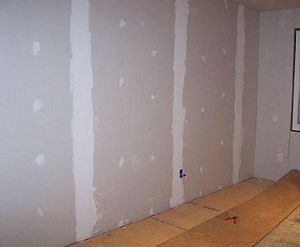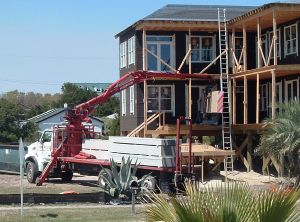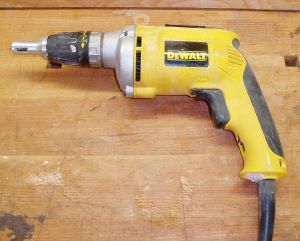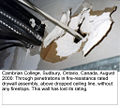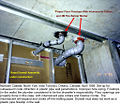Drywall
- "Sheetrock" redirects here.
Drywall is a common manufactured building material used globally for the finish construction of interior walls and ceilings. Each panel of drywall is made of a paper liner wrapped around an inner core made primarily from gypsum plaster, the semi-hydrous form of calcium sulfate (CaSO4.½ H2O).
The use of drywall offers the advantages of speed in construction and relative affordability. North America is one of the largest gypsum board users in the world, and the gypsum board market is one of the biggest beneficiaries when there is a housing boom.
Alternative names
Drywall is also commonly known as gypsum board, wallboard, plasterboard (U.S., UK, Ireland, Australia), Gibraltar board or gib (New Zealand—GIB being a trademark of Winstone Wallboards), rock lath, Sheetrock (a trademark of United States Gypsum Company), gyproc (Canada, Australia, UK), pladur (Spain—after the Pladur brand), or rigips (Germany and Central Europe—after the Rigips brand), or simply board.
Preparation of drywall
Raw gypsum must be calcined before use. Flash calciners typically use natural gas today. The plaster is mixed with fiber (typically paper and/or fiberglass), plasticizer, foaming agent, potash as an accelerator, EDTA or other chelate as a retarder, various additives that increase mildew and fire resistance (fiberglass or vermiculite), and water. This is then formed by sandwiching a core of wet gypsum between two sheets of heavy paper or fiberglass mats. When the core sets and is dried in a large drying chamber, the sandwich becomes rigid and strong enough for use as a building material. Drying chambers typically use natural gas today. Depending on plant efficiency and energy costs, 25-45 percent of drywall cost today is related to energy, primarily natural gas.
Construction techniques
As opposed to a week-long plaster application, an entire house can be drywalled in one or two days by two experienced drywall mechanics (drywallers) and drywall is easy enough to use that it can be installed by many amateur home carpenters. In large-scale commercial construction, the work of installing and finishing drywall is often split between the drywall mechanics, or hangers, who install the wallboard, and the tapers and mudmen, or float crew, who finish the joints and cover the nail heads with drywall compound.
Drywall is cut to size, using a large T-square, by scoring the paper on the front side (usually white) with a utility knife, breaking the sheet along the cut, scoring the paper backing, and finally breaking the sheet in the opposite direction. Small features such as holes for outlets and light switches are usually cut using a keyhole saw or a small high-speed bit in a rotary tool. Drywall is then fixed to the wall structure with nails, or more commonly in recent years, the now-ubiquitous drywall screws.
Drywall fasteners, also referred to as drywall clips or stops, are gaining popularity in both residential and commercial construction. Drywall fasteners are used for supporting interior drywall corners and replacing the non-structural wood or metal blocking that traditionally was used to install drywall. Their function serves to save on material and labor expenses; to minimize call backs due to truss uplift; to increase energy efficiency; and to make plumbing and electrical installation simpler. Many green building and energy efficiency models suggest using drywall fasteners to conserve resources and save energy, including the U.S. Dept. of Energy.
Drywall screws have a curved, bugle-shaped top, allowing them to self-pilot and install rapidly without punching through the paper cover. These screws are set slightly into the drywall. When drywall is hung on wood framing, screws having an acute point and widely spaced threads are used. When drywall is hung on light-gauge steel framing, screws having an acute point and finely spaced threads are used. If the steel framing is heavier than 20-gauge, self-tapping screws with finely spaced threads must be used. In some applications, the drywall may be attached to the wall with adhesives.
After the sheets are secured to the wall studs or ceiling joists, the seams between drywall sheets are concealed using joint tape and several layers of joint compound (sometimes called "mud"). This compound is also applied to any screw holes or defects. The compound is allowed to air dry then typically sanded smooth before painting. Alternatively, for a better finish, the entire wall may be given a skim coat, a thin layer (about 1 mm or 1/16 inch) of finishing compound, to minimize the visual differences between the paper and mudded areas after painting.
Another similar skim coating is always done in a process called veneer plastering, although it is done slightly thicker (about 2 mm or 1/8 inch). Veneering uses a slightly different specialized setting compound ("finish plaster") that contains gypsum and lime putty. For this application blueboard is used which has special treated paper to accelerate the setting of the gypsum plaster component. This setting has far less shrinkage than the air-dry compounds normally used in drywall, so it only requires one coat. Blueboard also has square edges rather than the tapered-edge drywall boards. The tapered drywall boards are used to countersink the tape in taped jointing whereas the tape in veneer plastering is buried beneath a level surface. One coat veneer plaster over dry board is an intermediate style step between full multi-coat "wet" plaster and the limited joint-treatment-only given "dry" wall.
Common drywall tools
- Benches
- Chalk line
- Checker
- Corner trowels
- Dimpler
- Drywall Adhesive Glue Guns
- Drywall Cart
- Drywall Fastener
- Drywall (Hatchet) Hammer
- Drywall Lifter
- Drywall Jack
- Drywall screws and nails
- Electric screwdriver
- Joint compound
- Keyhole saw or drywall router
- Pencil and Chalk
- Surform
- Screw gun
- Stud finder
- Tape Measure
- Taping/joint knives
- T-squares (48 and 54 inch)
- Utility knife
Levels of finish
Reviewing industry standards for gypsum board finish, George Kutcher, Jr., opens with the following statement in Tech Talk of the National Gypsum Association:[1]
In 1990, four major trade associations, the Association of Wall and Ceiling Industries International (AWCI), the Ceilings and Interior Systems Construction Association (CISCA), the Gypsum Association (GA), and the Painting and Decorating Contractors of America (PDCA), presented the consensus document Levels of Gypsum Board Finish. The document was created to "precisely describe" the desired finish of walls and ceilings prior to final decoration. This precise description enables contractors to better understand the requirements of architects and building owners in order to enhance the satisfaction of the client. Specifications that include the Levels of Gypsum Board Finish also promote competitive bidding that allows the bidder to consider the correct labor and materials to finish the wall suitably for its final decoration.
The official document (summarized below) is known as "Recommended Levels of Gypsum Board Finish."[2]
Level 0
No taping, finishing, or accessories required.
Usage: Temporary construction or when final decoration is undetermined.
Level 1
All joints and interior angles shall have tape set in joint compound. Surface shall be free of excess joint compound. Tool marks and ridges are acceptable.
Usage: Above false ceilings or other areas which are out of public view where a degree of fire and noise resistance is required.
Level 2
All joints and interior angles shall have tape embedded in joint compound and wiped with a joint knife leaving a thin coating of joint compound over all joints and interior angles. Fastener heads and accessories shall be covered with a coat of joint compound. Surface shall be free of excess joint compound. Tool marks and ridges are acceptable. Joint compound applied over the body of the tape at the time of tape embedment shall be considered a separate coat of joint compound and shall satisfy the conditions of this level.
Usage: As a substrate for tile walls and ceilings as well as in garages, warehouses, and other places where appearance is not a primary concern.
Level 3
All joints and interior angles shall have tape embedded in joint compound and one additional coat of joint compound applied over all joints and interior angles. Fastener heads and accessories shall be covered with two separate coats of joint compound. All joint compound shall be smooth and free of tool marks and ridges. It is recommended that the prepared surface be coated with a drywall primer prior to the application of final finishes.
Usage: Suitable base for heavy-medium textured paint or other thick finishes.
Level 4
All joints and interior angles shall have tape embedded in joint compound and two separate coats of joint compound applied over all flat joints and one separate coat of joint compound applied over interior angles. Fastener heads and accessories shall be covered with three separate coats of joint compound. All joint compound shall be smooth and free of tool marks and ridges. It is recommended that the prepared surface be coated with a drywall primer prior to the application of final finishes.
Usage: "Standard" household and office walls. Used with light or non-textured finishes. Not suitable for harsh lighting conditions which may highlight minor imperfections.
Level 5
All joints and interior angles shall have tape embedded in joint compound and two separate coats of joint compound applied over all flat joints and one separate coat of joint compound applied over interior angles. Fastener heads and accessories shall be covered with three separate coats of joint compound. A thin skim coat of joint compound, or a material manufactured especially for this purpose, shall be applied to the entire surface. The surface shall be smooth and free of tool marks and ridges. It is recommended that the prepared surface be coated with a drywall primer prior to the application of finish paint.
Usage: The skim coat is a final leveling agent suitable to smooth out a surface to be used under the harshest lighting conditions that may otherwise highlight any imperfections under the finished surface. This finish is highly recommended for gloss and entirely non-textured surfaces.
Fire resistance
When used as a component in fire barriers, drywall is a passive fire protection item. In its natural state, gypsum contains the water of crystallization bound in the form of hydrates. When exposed to heat or fire, this water is vaporized, retarding heat transfer. Therefore, a fire in one room that is separated from an adjacent room by a fire-resistance rated drywall assembly will prevent the adjacent room from getting any warmer than the boiling point of water (100°C), until the water in the gypsum is gone. This makes drywall an ablative material because as the hydrates sublime, a crumbly dust is left behind, which, along with the paper, is sacrificial.
Generally, the more layers of "Type X" drywall one adds, the more one increases the fire-resistance of the assembly, be it horizontal or vertical. Evidence of this can be found both in publicly available design catalogues on the topic, as well as common certification listings. Type X drywall is formulated by adding glass fibers to the gypsum, to increase the resistance to fires, especially once the hydrates are spent, which leaves the gypsum in powder form. Type X is typically the material chosen to construct walls and ceilings that are required to have a fire-resistance rating.
Fire testing of drywall assemblies for the purpose of expanding national catalogs—such as the National Building Code of Canada, Germany's Part 4 of DIN4102 and its British cousin BS476—are a matter of routine research and development work in more than one nation and can be sponsored jointly by national authorities and representatives of the drywall industry. For example, the National Research Council of Canada routinely publishes such findings.[3] The results are printed as approved designs in the back of the building code. Generally, exposure of drywall on a panel furnace removes the water and calcines the exposed drywall and also heats the studs and fasteners holding the drywall. This typically results in deflection of the assembly towards the fire, as that is the location where the sublimation occurs, which weakens the assembly, due to the fire influence.
Another example: This steel sleeve, a penetrant itself, causes more problems than it solves.
North American market
North America hails as one of the largest gypsum board users in the world with a total wallboard plant capacity of 40 billion square feet per year.[4] Moreover, the home building and remodeling markets in North America have increased demand the last five years. The gypsum board market is one of the biggest beneficiaries of the housing boom as "an average new American home contains more than 7.31 metric tons of gypsum."[5]
The introduction in March 2005, of the Clean Air Interstate Rule by the United States Environmental Protection Agency requires power plants to reduce sulfur dioxide emissions by 73 percent by 2018.[6] This rule also requested that power plants install new scrubbers (industrial pollution control devices) to remove sulfur dioxide present in the output waste gas. Scrubbers use the technique of flue gas desulfurization (FGD), which produces synthetic gypsum as a usable by-product. In response to the new supply of this raw material, the gypsum board market was predicted to shift significantly. However, issues such as mercury release during calcining need to be resolved.[7]
Specifications
In the United States and Canada
Drywall is typically available in 4 ft (1219 mm) wide sheets of various lengths. With the rising popularity of 9 ft (2.7 m) high ceilings in new home construction, 4.5 ft (1372 mm) wide panels have become commonly available as well. Newly formed sheets are cut from a belt, the result of a continuous manufacturing process. In some commercial applications, sheets up to 16 ft (4.9 m) are used. Larger sheets make for faster installation, since they reduce the number of joints that must be finished. Often, a sizable quantity of any custom length may be ordered, from factories, to exactly fit ceiling-to-floor on a large project.
The most commonly used drywall is one-half-inch thick but can range from one quarter (6.35 mm) to one inch (25.4 mm). For soundproofing or fire resistance, two layers of drywall are sometimes laid at right angles to each other. In North America, five-eighths-inch-thick drywall with a one-hour fire-resistance rating is often used where fire resistance is desired.
Drywall provides a thermal resistance R-value of 0.32 for three-eighths-inch board, 0.45 for half inch, 0.56 for five-eighths inch and 0.83 for one-inch board. In addition to increased R-value, thicker drywall has a higher sound transmission class.
In the United Kingdom
In the UK, plasterboard is typically manufactured in metric sizes, with the common sizes being close to the earlier imperial sizes.
Most plasterboard is made in 1200 mm wide sheets, though 900 mm wide sheets are also made. 1200 mm wide plasterboard is most commonly made in 2400 mm lengths, though 2700 mm and 3000 mm length sheets are also commonly available.
The most commonly used thicknesses of plasterboard available are 12.5 mm (modern equivalent of half an inch), typically used for walls, and 9.5 mm (modern equivalent of three-eights of an inch), typically used for ceilings. 15 mm thick board is commonly available, and other thicknesses are also produced.
Plasterboard is commonly made with one of two different edge treatments: Tapered Edge, where the sides of the board are tapered at the front to allow for jointing materials to be finished flush with the main board face, and Straight Edge, where there is no different thickness at the side of the board.
Types available in the U.S. and Canada
- Regular white board, from 1/4" to 3/4" thickness
- Fire-resistant ("Type X"), different thicknesses and multiple layers of wallboard provide increased fire rating based on the time a specific wall assembly can withstand a standardized fire test. Often perlite, vermiculite and boric acid are added to improve fire resistance.
- Greenboard, the drywall that contains an oil-based additive in the green colored paper covering that provides moisture resistance. It is commonly used in washrooms and other areas expected to experience elevated levels of humidity.
- Blueboard or gypsum base, the blue face paper forms a strong bond with a skim coat or a built-up plaster finish
- Cement backerboard, which is more water-resistant than greenboard, for use in showers or sauna rooms, and as a base for ceramic tile
- Soundboard is made from wood fibers to increase the sound rating (STC)
- Soundproof drywall such as QuietRock is a laminated drywall made with gypsum, other materials, and damping polymers to significantly increase the STC
- Mold-resistant, paperless drywall from Georgia-Pacific
- Enviroboard, a board made from recycled agricultural materials
- Lead-lined drywall, a drywall used around radiological equipment
- Foil-backed drywall to control moisture in a building or room
Handling waste
Because up to 17 percent of drywall is wasted during the manufacturing and installation processes, and the drywall material is rarely re-used, disposal has become a problem. Some landfill sites have banned the dumping of drywall. Therefore, used drywall and gypsum are often dumped into the ocean where it may cause harm to sea life. The EPA regulates this ocean dumping by permit. Most manufacturers with an environmental concern take back the boards from construction sites, and burn them at high temperature to eliminate the paper and bring the gypsum back to its initial plaster state. Recycled paper is sometimes used during manufacturing.
More recently, recycling at the construction site itself is being investigated. There is potential for using crushed drywall to amend certain soils at building sites, such as clay and silt mixtures (bay mud), as well as using it in compost.[8] However, drywall that is composed of non-biodegradable or persistent toxic additives—including EDTA, most plasticizers, and some mildew and fire retardants—presents a challenge, in that it cannot be safely returned to soil or reclaimed by industry without compromising human and environmental health.
See also
- Cement
- Construction
- Fiberglass
- Fire
- Fire protection engineering
- Gypsum
- Masonry
- Paper
- Plaster
- Plumbing
- Potash
Notes
- ↑ National Gypsum Company, Tech Talk: Revisiting the Levels of Gypsum Board Finish. Retrieved September 19, 2008.
- ↑ AWCI, CISCA, GA, PDCA, GA-214-96, Recommended Levels of Gypsum Board Finish. Retrieved September 19, 2008.
- ↑ V.R. Kodur and M.A. Sultan, Performance of wood stud shear walls exposed to fire, National Research Council of Canada. Retrieved September 19, 2008.
- ↑ Mineral Commodity Summaries, Gypsum. Retrieved September 6, 2008.
- ↑ Donald W. Olson, Gypsum, USGS. Retrieved September 6, 2008.
- ↑ Environmental Protection Agency, Clean Air Interstate Rule. Retrieved September 6, 2008.
- ↑ Loreal V. Heebink and David J. Hassett, Mercury Release from FGD Gypsum, Flyash.info. Retrieved September 6, 2008.
- ↑ California Integrated Waste Management Board, Recycled Inerts. Retrieved September 6, 2008.
ReferencesISBN links support NWE through referral fees
- Ferguson, Myron. Drywall: Professional Techniques for Great Results. Newtown, CT: Taunton Press, 2008. ISBN 1561589551
- Scharff, Robert. Drywall Construction Handbook. New York: McGraw-Hill, 1995. ISBN 0070571244
- Wagner, John D., and Clarke Barre. Drywall: Pro Tips for Hanging & Finishing. Upper Saddle River, NJ: Creative Homeowner Press, 2005. ISBN 1580112706
External links
All links retrieved January 30, 2024.
- Pictures of Various Drywall Textures. drywallschool.com.
- Drywall Information For The Do-It-Yourselfer. (A stepwise tutorial for taping and finishing drywall.)
- Gypsum Association.
- Drywall recycling.
Credits
New World Encyclopedia writers and editors rewrote and completed the Wikipedia article in accordance with New World Encyclopedia standards. This article abides by terms of the Creative Commons CC-by-sa 3.0 License (CC-by-sa), which may be used and disseminated with proper attribution. Credit is due under the terms of this license that can reference both the New World Encyclopedia contributors and the selfless volunteer contributors of the Wikimedia Foundation. To cite this article click here for a list of acceptable citing formats.The history of earlier contributions by wikipedians is accessible to researchers here:
The history of this article since it was imported to New World Encyclopedia:
Note: Some restrictions may apply to use of individual images which are separately licensed.
